The Neapolitan cuopporepresents the very essence of thestreet foodNeapolitan, a gastronomic icon that contains the history, tradition and culinary innovation of Naples. This simple but irresistible cone of straw paper, full of fried delights, is much more than a simple snack: it is a sensory experience that transports those who taste it to the beating heart of Neapolitan culture. Born as poor food in the nineteenth century, Cuoppo has crossed the centuries, evolving and adapting to modern tastes, while keeping his authentic soul intact. Today, walking through the streets of Naples, it is impossible not to come across the inviting perfume that is released from the fryers, where skilled hands prepare these cones of goodness for clubs and tourists.
On this gastronomic journey, we will explore every aspect ofNeapolitan cuoppo: From its fascinating history to the different variants that today delight the most demanding palates. We will discover the secrets of perfect frying, preparation techniques and curiosities related to this symbol of Neapolitan cuisine. Whether you are lovers of fish, vegetables or desserts, Cuoppo has something to offer to everyone, representing a real kaleidoscope of flavors and textures.
Get ready to immerse yourself in a world of crunchiness and taste, where each bite tells a story of tradition, passion and culinary creativity. TheNeapolitan cuoppo non è solo un cibo: è un pezzo di Napoli da portare con sé, un ricordo indelebile di una città che sa conquistare attraverso i sapori della sua straordinaria cucina.
The origins of the Neapolitan Cuoppo
The Neapolitan cuoppo affonda le sue radici nella Napoli dell’Ottocento, un’epoca in cui la città partenopea viveva profondi cambiamenti sociali ed economici. Questa prelibatezza nacque come risposta creativa alla necessità di offrire un pasto sostanzioso e conveniente alle classi meno abbienti.
From poverty to tradition
Le strade di Napoli, brulicanti di vita e attività, videro emergere i primi venditori ambulanti di cuoppo. Questi ingegnosi commercianti acquistavano al mercato del pesce i pezzi più piccoli e meno pregiati, quelli che difficilmente avrebbero trovato acquirenti tra i clienti più facoltosi. Con abilità e inventiva, trasformavano questi umili ingredienti in un piatto gustoso e accessibile a tutti. Il processo di preparazione era semplice ma efficace: i pesciolini e gli scarti venivano puliti sommariamente, passati in una pastella leggera fatta di acqua e farina e poi fried in olio bollente. Il risultato era un mix croccante e saporito che veniva servito in un cono di carta paglia, pratico da mangiare camminando e capace di assorbire l’eventuale unto in eccesso.
Evolution over time
Con il passare degli anni, il cuoppo si è evoluto, incorporando nuovi ingredienti e tecniche di preparazione. Dalle strade, questo cibo ha fatto il suo ingresso nelle friggitorie, nei ristoranti e persino nelle case dei napoletani, diventando un simbolo della cucina locale.
La versatilità del cuoppo ha permesso la nascita di diverse varianti, ognuna capace di soddisfare gusti e preferenze diverse. Dal mare alla terra, fino alle versioni dolci, il cuoppo ha dimostrato una straordinaria capacità di adattarsi e rinnovarsi, pur mantenendo intatto il suo spirito originario.
An icon of street food
Oggi, ilNeapolitan cuoppoIt is recognized as one of the pillars of Italian street food. His popularity has crossed the borders of Naples, spreading throughout Italy and even abroad, where he is appreciated as an authentic expression of the Neapolitan gastronomic culture.
The strength of Cuoppy lies in its simplicity and in its ability to offer a complete culinary experience in a practical and informal format. Perfectly represents the soul of Naples: creative, generous and capable of transforming simple ingredients into something extraordinary.
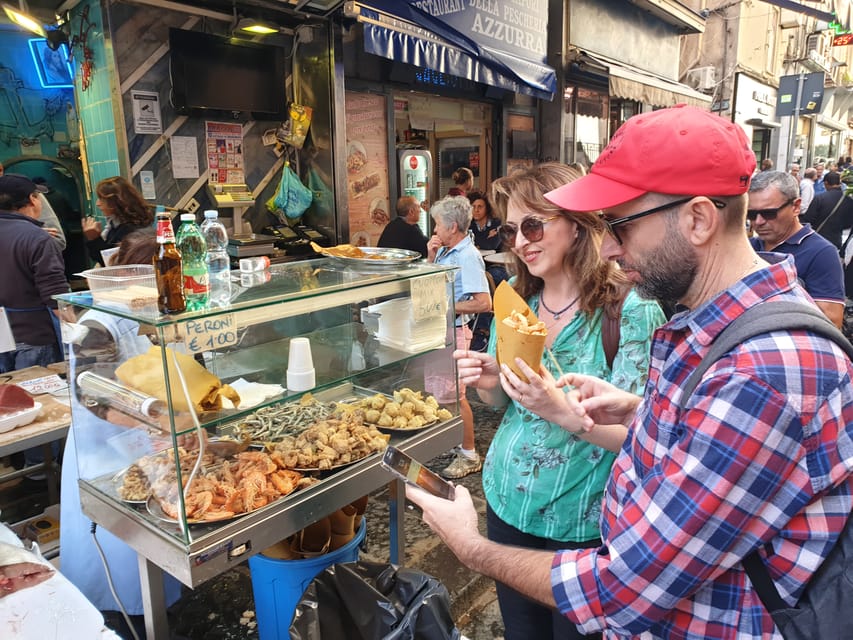
The variants of Cuoppo: a triumph of flavors
The Neapolitan cuoppo, nella sua apparente semplicità, nasconde un mondo di varietà e possibilità. Nel corso del tempo, la creatività dei cuochi partenopei ha dato vita a diverse interpretazioni di questo classico street food, ognuna capace di soddisfare palati diversi e di rappresentare al meglio la ricchezza gastronomica di Napoli.
The sea cuoppo: a dip in the flavors of the Mediterranean
The sea cuoppo è forse la variante più conosciuta e amata. Questo trionfo di frittura marina racchiude in sé tutta la generosità del Mar Mediterraneo. Gli ingredienti principali includono:
- Fried anchovies: small blue fish, rich in omega-3, made crunchy by frying.
- Calamari: golden and tender rings, a timeless classic.
- Shrimp: sweets and juicy, with their characteristic consistency.
- Cod: pieces of salty cod, a Neapolitan tradition.
- Zeppoline'salgae: small flavored pancakes withalgaemarine.
La preparazione di questi ingredienti richiede una mano esperta: ogni elemento viene accuratamente pulito, tagliato in pezzi di dimensioni adeguate e poi passato in una pastella leggera prima di essere fritto. Il risultato è un mix di sapori e consistenze che trasporta chi lo assaggia direttamente sulle coste napoletane.
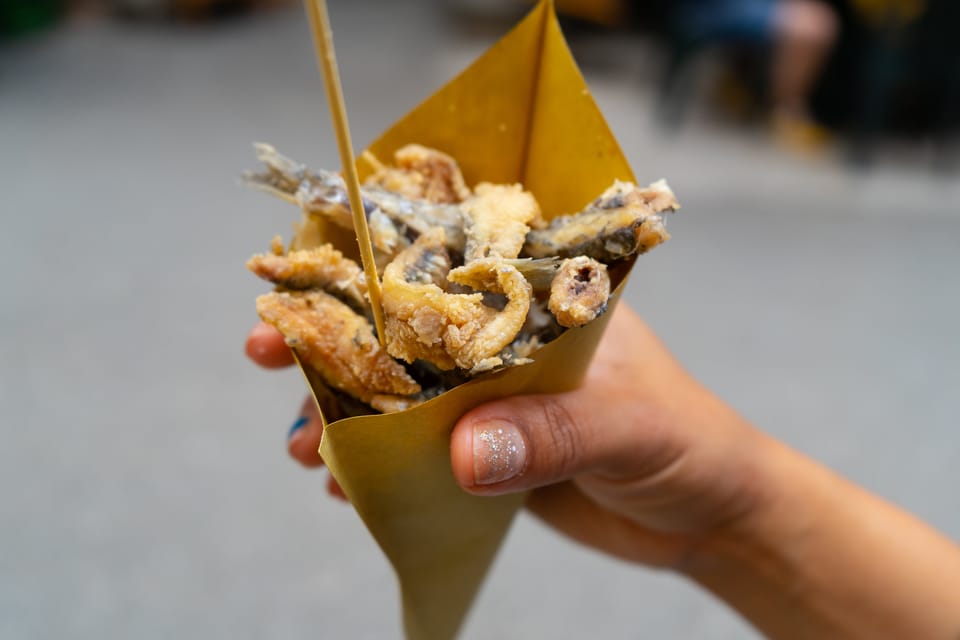
The Copopo di Terra: the abundance of the hinterland
Non meno gustoso è il cup of earth, che celebra i prodotti dell’entroterra campano. Questa variante è un tripudio di verdure, formaggi e specialità locali, tra cui:
- Crocchè di patate: cilindri di purè di patate, spesso arricchiti con cheese and parsley.
- Fried mozzarelline: small spheres of breaded and fried mozzarella with a stringy heart.
- Zeppole dipastaGrowing up: balls of leavened pasta, light and soft.
- Flowers ofpumpkinIn batter: delicate flowers covered with a crunchy batter.
- Eggplant andzucchiniFried: thin slices of vegetables, golden and irresistible.
Ogni elemento viene preparato con cura, rispettando le tradizioni culinarie napoletane. La frittura deve essere perfetta: croccante all’esterno e morbida all’interno, capace di esaltare il sapore naturale di ogni ingrediente.
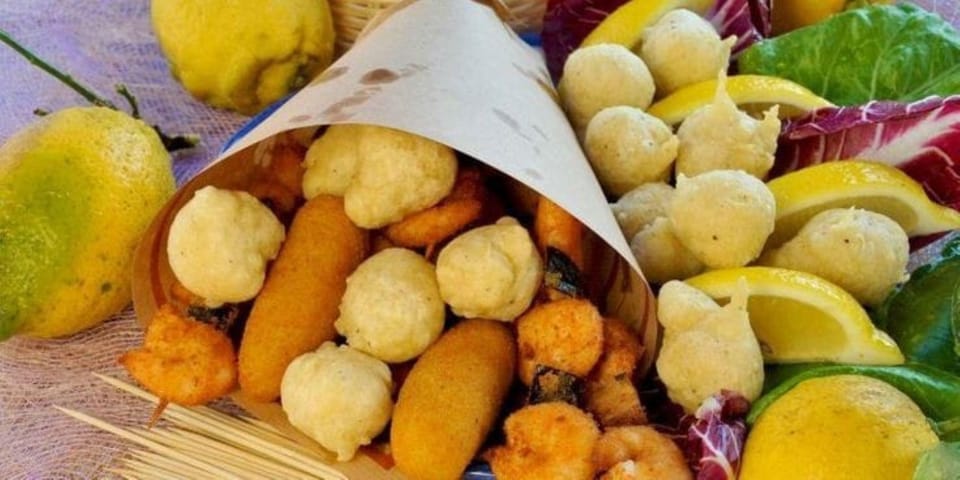
The sweet Cuoppo: a sweet conclusion
Più recente ma non meno apprezzata è la variante dolce del cuoppo. Questa interpretazione creativa trasforma il classico street food in un dessert da passeggio, perfetto per concludere un pasto o come golosa merenda. Tra le delizie che si possono trovare in un sweet cup ci sono:
- Sweet Zeppole: the classic Neapolitan pancakes, sprinkled with granulated sugar.
- Pancakesapples: apple slices immersed in batter and fried, a real autumn delight.
- Mini Babà Friedi: miniature versions of the famous Neapolitan dessert, fried and soaked in rum.
- Castagnole: small balls of sweet pasta, fried and flavored with liqueur.
La preparazione del cuoppo dolce richiede una particolare attenzione alla temperatura dell’olio e ai tempi di cottura, per garantire che ogni boccone sia perfettamente dorato e croccante, senza risultare pesante.
The art of composition
La vera maestria nella preparazione del cuoppoIt manifests itself not only in the fry of the individual elements, but also in their composition within the cone. AcuoppoWell done it is a perfect balance of flavors, textures and temperatures. The heaviest elements are positioned on the bottom, while the lighter and more delicate ones are arranged at the top, creating a gustatory experience that evolves with each bite.
The versatility ofNeapolitan cuoppo dimostra come questa tradizione culinaria sia capace di reinventarsi continuamente, pur mantenendo salde le proprie radici. Che si tratti di mare, terra o dolce, ogni variante racconta una storia di Napoli, dei suoi sapori e della sua inesauribile creatività gastronomica.
The secrets of perfect Neapolitan frying
La frittura è l’anima del Neapolitan cuoppo, e dietro a quella croccantezza dorata si nasconde un’arte raffinata, tramandata di generazione in generazione. La perfezione di un cuoppo dipende in larga misura dalla qualità della sua frittura, un processo che richiede conoscenza, esperienza e un tocco di magia culinaria.
The choice of oil: the foundation of a good frying
Il primo segreto per una frittura impeccabile sta nella scelta dell’olio. I maestri friggitori napoletani prediligono l’olio di peanuts per diverse ragioni:
- High point of smoke: it resists high temperatures without burning.
- Neutral flavor: does not alter the natural taste of the ingredients.
- Stability: maintains its properties even after different fries.
Alcuni preferiscono miscelare l’olio di peanuts con una piccola percentuale di olio d’oliva, per conferire un aroma più mediterraneo al fritto. La chiave è mantenere l’olio pulito e cambiarlo regolarmente per garantire sempre risultati ottimali.
The temperature: the thermometer of success
Il controllo della temperatura è cruciale per ottenere una frittura perfetta. L’olio deve essere portato a una temperatura compresa tra i 170°C e i 180°C, a seconda degli ingredienti da fry:
- Lower temperature (170 ° C): for delicate ingredients such as fish.
- Higher temperature (180 ° C): for more substantial vegetables and doughs.
Un termometro da cucina è lo strumento ideale per monitorare la temperatura, ma i friggitori esperti sviluppano un “sesto senso” che permette loro di valutare la temperatura dell’olio osservando la formazione delle bolle intorno a un pezzetto di pane immerso.
The batter: the secret of crunchiness
La pastella è un elemento fondamentale per molti ingredienti del cuoppo. Una buona pastella deve essere:
- Light: In order not to weigh down the ingredients.
- Crunchy: to create that contrast of consistency so loved.
- Adherent: not to detach yourself during frying.
La ricetta base prevede farina, acqua frizzante (per una maggiore leggerezza) e un pizzico di sale. Alcuni aggiungono un uovo per una maggiore consistenza, o beer per un sapore più complesso. La pastella deve riposare in frigorifero per almeno 30 minuti prima dell’uso, per permettere agli amidi di gonfiarsi e garantire una migliore aderenza.
Frying techniques
La frittura richiede attenzione e precisione. Ecco alcuni accorgimenti fondamentali:
- Do not overwhelm the pan: too many ingredients simultaneously lower the oil temperature.
- Drain well: use a skimmer to remove excess oil.
- Salt at the end of cooking: the salt during frying would absorb more oil.
- Keep hot: use a low temperature oven to keep the fried foods crunchy waiting to be served.
The importance of rest and drying
Dopo la frittura, è fondamentale lasciare riposare gli ingredienti su carta assorbente. Questo passaggio permette di eliminare l’eccesso di olio, mantenendo la croccantezza esterna e la morbidezza interna. Un cuoppo ben fatto non deve mai risultare unto o pesante.
Modern innovations: air frying
Sebbene la tradizione rimanga ancorata alla frittura classica, alcune versioni moderne del cuoppo sperimentano con la air frying. This technique, which uses circulating hot air instead of oil, promises similar results with a significantly reduced fat content. However, purists claim that the flavor and consistency obtained with traditional frying are inimitable.
Perfection in Neapolitan fry is the result of centuries of experience, passion and dedication. Each Copopo tells this story of culinary skill, offering those who taste it not only a meal, but an authentic Neapolitan gastronomic experience.
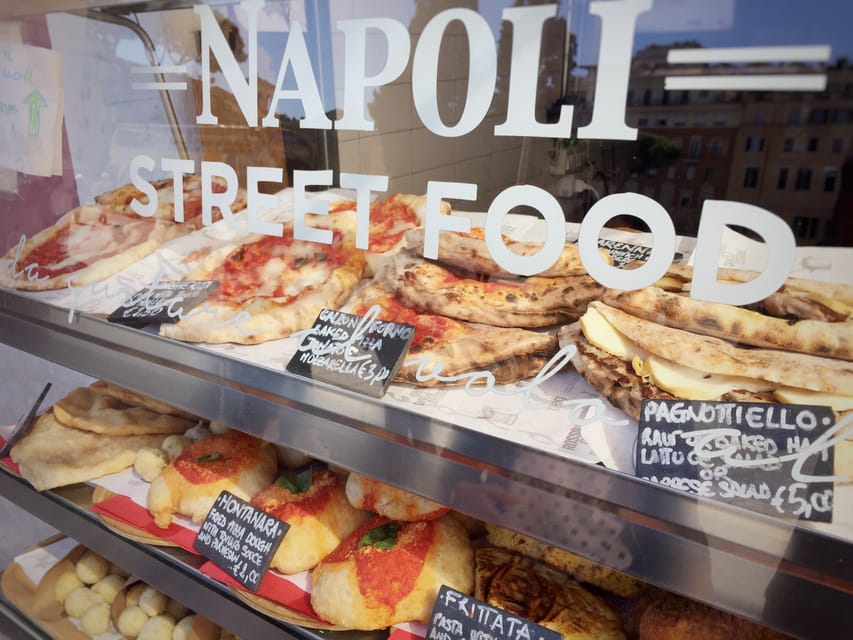
The art of the composition of the Cuoppy
La preparazione del Neapolitan cuoppo non si esaurisce con la frittura degli ingredienti. L’assemblaggio del cono è un’arte a sé stante, che richiede esperienza, creatività e un occhio attento all’estetica. Un cuoppo ben composto non è solo un piacere per il palato, ma anche per gli occhi, invitando chi lo osserva a immergersi in un’esperienza gastronomica unica.
The choice of the container: not just a detail
Il cono di carta paglia, elemento distintivo del cuoppo, non è una scelta casuale. Questo materiale offre diversi vantaggi:
- Absorbency: captures any grease in excess, keeping the ingredients crunchy.
- Resistance: supports the weight of the ingredients without selling.
- Sustainability: being biodegradable, it is an ecological choice.
Le dimensioni del cono variano a seconda della porzione, ma generalmente si aggira intorno ai 20-25 cm di altezza. Alcuni locali più moderni sperimentano con contenitori alternativi, come coni di carta alimentare decorata o persino versioni riutilizzabili in materiali ecosostenibili.
The stratification: an architecture of flavors
La disposizione degli ingredienti nel cuoppo segue una logica precisa:
- Sturdy base: the heaviest and most resistant elements must be positioned on the bottom, such as crocchè or pieces of cod.
- Scendio layer: here there are medium consistency ingredients, such as squid and zeppoline.
- Superior layer: the lightest and most delicate elements, such as shrimp or flowers ofpumpkin.
- Garnish: Some particularly appetizing pieces are positioned in plain sight to tease the appetite.
Questa disposizione non è casuale: permette di mantenere la croccantezza di ogni elemento, evitando che i pezzi più pesanti schiaccino quelli più delicati.
The balance of flavors
Un cuoppo ben composto deve offrire una varietà di sapori e consistenze in ogni boccone. L’abilità sta nel bilanciare:
- Flavors of sea and land
- Crispy and soft elements
- Intense and delicate flavours
Ad esempio, in un cuoppo misto, si potrebbe alternare un boccone di alici fritte con uno di crocchè di patate, seguito da un calamaro e poi da una zeppola. Questa alternanza crea un’esperienza gustativa dinamica e coinvolgente.
The presentation: eating with eyes
L’aspetto visivo del cuoppo è fondamentale per stimolare l’appetito. Alcuni accorgimenti per una presentazione accattivante includono:
- Contrast of colors: alternate golden elements with touches of green (such asparsleyfried) or red (dry cherry tomatoes).
- Height: Create volume by positioning some vertical elements.
- Freshness: add a touch oflemonfresh orherbsaromatic on top.
Alcuni locali servono il cuoppo in supporti appositi, che ne esaltano la presentazione e ne facilitano la condivisione.
Personalization and innovation
Sebbene esistano composizioni classiche, molti locali offrono la possibilità di personalizzare il proprio cuoppo. Questa flessibilità permette di adattarsi a diverse esigenze dietetiche o preferenze personali. Alcune innovazioni recenti includono:
- Vegetarian Cuoppo: with a selection of fried vegetables and cheeses.
- Gluten -free cuoppo: using alternative flours for the batter.
- Cuoppo Fusion: which incorporates elements of other kitchens, such as Japanese tempura or Middle Eastern Falafel.
The importance of timing
Un cuoppo deve essere consumato il prima possibile dopo la preparazione per godere appieno della sua croccantezza. Per questo motivo, i migliori locali preparano il cuoppo al momento dell’ordine, garantendo la massima freschezza.
The art of composingNeapolitan cuoppoIt is a delicate balance between tradition and innovation, technique and creativity. Each Copopo tells a story of Naples, its flavors and its ability to transform simple ingredients into an unforgettable gastronomic experience.
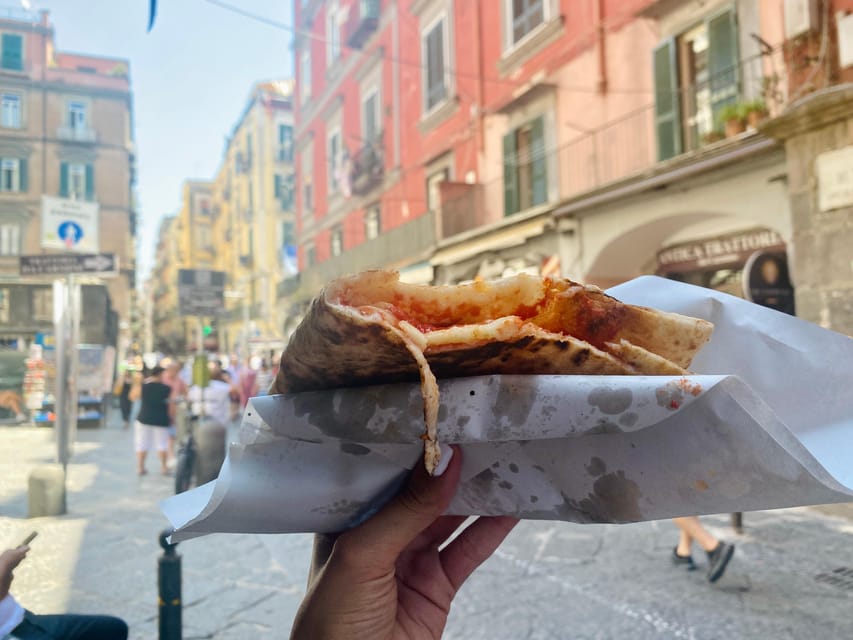
The Cuoppy in Neapolitan culture
The cuoppo non è solo un cibo, ma un vero e proprio simbolo della cultura napoletana, profondamente radicato nella storia e nelle tradizioni della città. Questo semplice cono di carta paglia ricolmo di delizie fritte racchiude in sé molto più di un semplice pasto: è un’espressione dell’anima di Napoli, della sua creatività culinaria e della sua capacità di trasformare la necessità in virtù.
A symbol of conviviality
Nella cultura napoletana, il cibo è da sempre un elemento di aggregazione sociale, e il cuoppo non fa eccezione. Condividere un cuoppo con amici o familiari è un rituale che va oltre il semplice atto di mangiare:
- Create moments of sharing and joy
- Favors the conversation and exchange of opinions
- Strengthens social and family ties
Non è raro vedere gruppi di persone riunite intorno a un cuoppo, ognuno che pesca dal cono comune, in un’atmosfera di gioia e convivialità tipicamente napoletana.
The Cuoppo in everyday language
L’importanza del cuoppo nella cultura napoletana si riflette anche nel linguaggio quotidiano. Sono nate diverse espressioni e modi di dire legati a questo cibo, che arricchiscono il già colorito dialetto partenopeo:
- "Keep 'o cuoppo": Literally" keeping the cuoppo ", it means having a good opportunity or being in an advantageous position.
- "Be commente 'nu cucoppo' and fried fish“: Being like a fried fish cuoppo or being highly appreciated or refined.
- "Come on, come on“: Being Copopo, in the sense of collecting or putting something together.
Queste espressioni dimostrano come il cuoppo sia entrato a far parte non solo della dieta, ma anche dell’immaginario collettivo napoletano.
Cuoppo in art and literature
L’iconicità del cuoppo ha ispirato artisti e scrittori nel corso degli anni. Numerose opere d’arte, dalle pitture alle sculture, hanno immortalato scene di vita napoletana con il cuoppo come protagonista. Nella letteratura, diversi autori hanno utilizzato il cuoppo come metafora della vita napoletana:
- As a symbol of abundance and generosity
- As a representation of the ability to get by (the art of "if arranging")
- As an element of nostalgia for Neapolitan emigrants
Un esempio celebre è il romanzo “Il mare non bagna Napoli” di Anna Maria Ortese, dove il cuoppo appare come un elemento ricorrente, simbolo della Napoli popolare e autentica.
Cuoppo as a tourist attraction
Con il crescente interesse per il turismo gastronomico, il cuoppoIt has become a real attraction for visitors to Naples. Manyculinary toursinclude a stage dedicated to tasting thisiconic street food, offrendo ai turisti non solo un assaggio di sapori autentici, ma anche un’immersione nella cultura locale. Alcuni aspetti che rendono il cuoppo particolarmente attraente per i turisti sono:
- His practicality: easy to eat walking
- Its low cost: accessible to all budgets
- Its variety: offers a taste of several flavors in a single portion
Molti locali hanno saputo capitalizzare su questa tendenza, creando tasting experiences che vanno oltre il semplice acquisto del cuoppo, includendo spiegazioni sulla sua storia e dimostrazioni di preparazione.
Cuoppo as a symbol of resilience
La storia del cuoppo, born as poor food and become a gastronomic icon, reflects in many ways the resilience and creativity of the Neapolitan people. In a often difficult historical context, Neapolitans have been able to transform the need into virtue, creating from simple and economic ingredients a dish that is now appreciated all over the world.
This ability to adapt and innovation is also reflected in the modern evolution of Cuoppo, which continues to reinvent itself while maintaining its roots in tradition. TheNeapolitan cuoppo, therefore, is not only a food, but a real cultural phenomenon. It represents the essence of Naples: its history, its creativity, its ability to transform the little. Each bite ofcuoppoIt is a taste not only of flavors, but of an entire culture, rich, complex and fascinating like few others in the world.
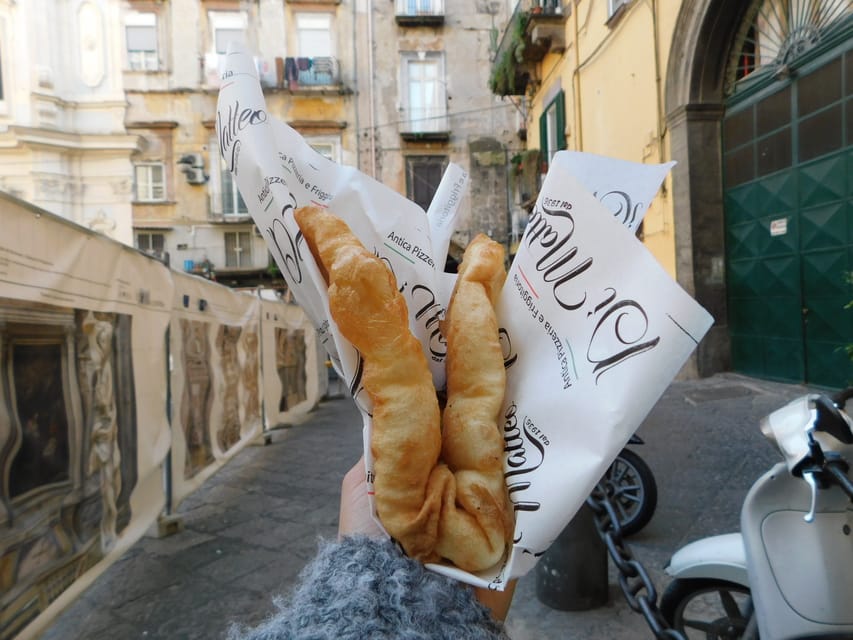
The Cuoppy in the context of global street food
Il cuoppo napoletano, con la sua storia centenaria e il suo profondo radicamento nella cultura partenopea, si inserisce oggi in un contesto più ampio: quello dello street food globale. In un’epoca in cui il cibo di strada sta vivendo una rinascita e una rivalutazione a livello mondiale, il cuoppo si distingue come un esempio eccellente di come la tradizione possa incontrare le tendenze contemporanee.
Cuoppo and global street food trends
Lo street food, negli ultimi anni, ha conosciuto un boom di popolarità in tutto il mondo. Questo fenomeno si deve a diversi fattori:
- Research of authenticity: consumers are increasingly interested in genuine and rooted culinary experiences in local culture.
- Convenience: street food offers fast and accessible meals in increasingly frenetic urban contexts.
- Experimentation: Street Food allows you to taste a variety of flavors in contained portions.
- Sociality: street food favors sharing and social interaction.
Il cuoppo napoletano si inserisce perfettamente in queste tendenze, offrendo:
- An authentic experience of Neapolitan culture
- A quick and convenient meal
- A variety of flavors in a single portion
- An ideal format for sharing
Comparison with other international street food
Nel panorama globale dello street food, il cuoppo si distingue per le sue caratteristiche uniche, pur condividendo alcuni elementi con altre specialità internazionali:
-
Fish and Chips (Regno Unito):
- Simi: both offer fried fish
- Differences: the Cuoppo presents a greater variety of ingredients
-
Tempura (Giappone):
- Similaritudes: light fry technique
- Differences: Cuoppo uses a different batter and also includes non -fried elements
-
Falafel (Medio Oriente):
- Similaritudes: practical format to eat on the move
- Differences: the Cuoppo offers a greater variety of ingredients, not just vegetables
- arancini
(Sicilia):
- Similaritudes: both are specialties from Southern Italy
- Differences: the Cuoppo presents a greater variety of ingredients and preparation techniques
The adaptation of the Cuoppon to international markets
Con la crescente popolarità della cucina italiana nel mondo, il cuoppo ha iniziato a farsi strada anche al di fuori dei confini nazionali. Questo processo di internazionalizzazione ha portato a interessanti adattamenti:
- Local ingredients: in some countries, Cuoppy is reinterpreted using typical local ingredients.
- Fusion versions: Cuoppi are born that mix the Neapolitan tradition with culinary influences from other countries.
- Gourmet formats: in some high cuisine restaurants, the Cuoppo is offered in refined and innovative versions.
Questi adattamenti, se da un lato rischiano di allontanarsi dalla tradizione originale, dall’altro contribuiscono a diffondere la conoscenza di questo piatto partenopeo.








